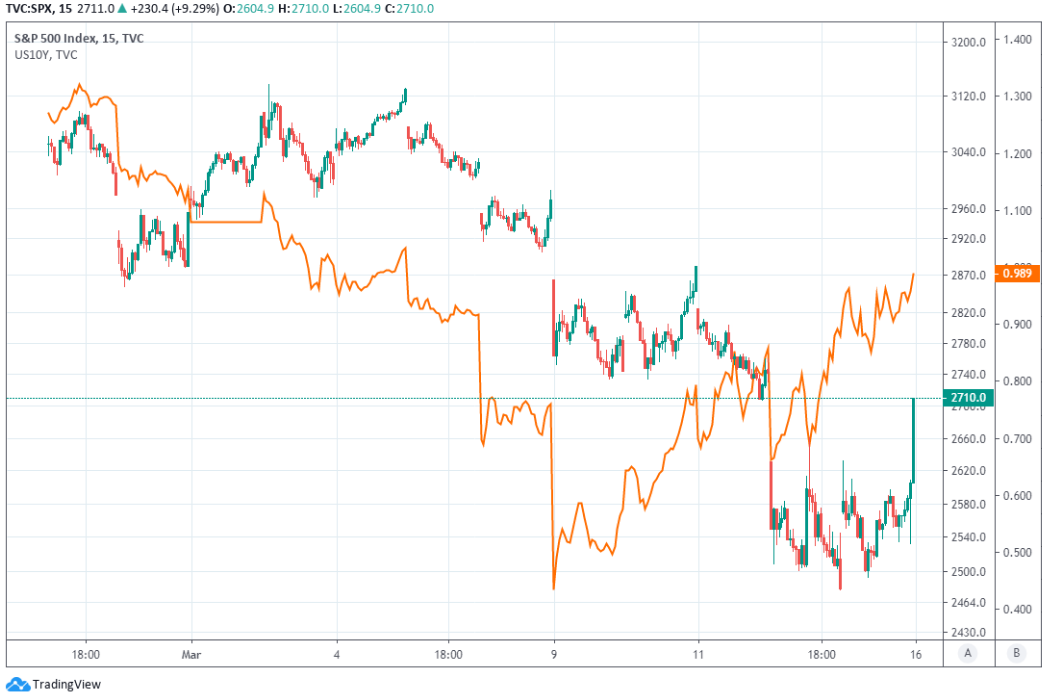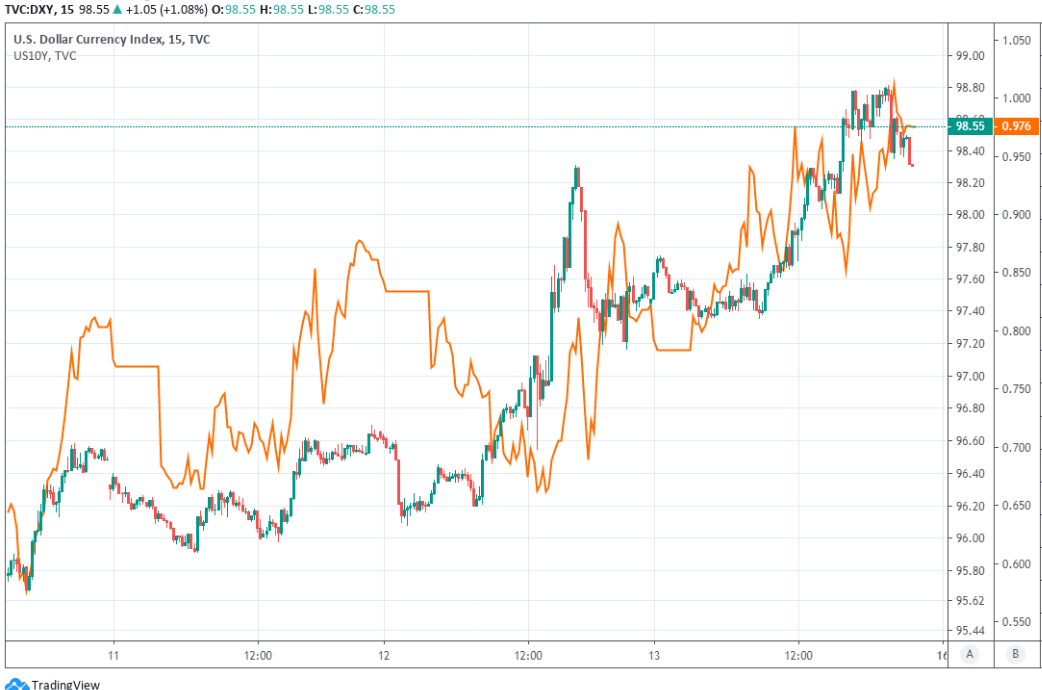Dollar and Bonds Fall, Stocks and Oil Rally as U.S. Declares Emergency
- Written by: James Skinner
-
-USD and safe-haven bonds fall after Trump declares emergency.
-To "unleash" the federal government as coronavirus hits 46 states.
-Touts $50bn in funding for states, interest waivers on federal loans.
-Eyes strategic oil reserve; says to "fill it right up" after price crash.
-Sends stocks and oil rallying into the weekend after brutal losses.
-But Trump says next 8 weeks are crucial, warns of sacrifices ahead.
-Says UK could also see travel ban after coronavirus cases spike.
-GBP/USD crashes through key level, risks sheer drop to 1.20 ahead.

Image © White House
- GBP/USD Spot rate: 1.2264, -2.3% on publication
- Indicative bank rates for transfers: 1.2024-1.2110
- Transfer specialist indicative rates: 1.2171-1.2245 >> Get your quote now
The Dollar and safe-haven U.S. bond fell stalled late on Friday as stock and oil prices rallied into the weekend after President Donald Trump declared a national emergency and announced a range of emergency measures to bolster the U.S. economy as it grapples with a coronavirus outbreak.
Dollar exchange rates retreated and U.S. yields appeared to stall Friday amid an apparent stampede by investors back into the stock markets that were sold so heavily in Thursday's session, with the S&P 500 rising close to 5% in the wake of President Trump's address, taking its intraday gain into the double digits and its return from the rally off Thursday's lows to more than 12%.
The S&P was on course for its worst week in history after Thursday's close, which compelled the Federal Reserve into a successful attempt at catching a falling knife, but the index has now nearly backfilled the entire trough carved out for it previously in what was the bloodiest trading session since the financial crisis, and oil prices had risen nearly 10% off Friday's lows.
This was after Trump proclaimed the U.S. is in a national emergency, giving the government new powers to confront an outbreak of the deadly viral pneumonia that's so-far spread to 46 states.
"To unleash the full power of the federal government in this effort today I am officially declaring a national emergency. Two very big words. The action I am taking will open up access to up to $50 bn of very important and a large amount of money for states and territories and localities in our shared fight against this disease. In furtherance of the order I am urging ever state to set up emergency operation centres effective immediately," - President Donald Trump.

Above: S&P 500 stock market index rises at 15-minute intervals alongside 10-yr U.S. Gov bond yield.
Trump said Americans will have to make sacrifices in the coming months and that the next eight weeks are crucial to limiting the damage done by the disease that's spread rapidly since escaping China's borders in late January. He announced waivers for interest payments on all federal loans including student loans and that he's asked the Department of Energy to purchase oil for the strategic petroleum reserve, noting that he's asked them to "fill it to the top".
He also said that further policy announcements will follow, as expectations of coordinated fiscal and monetary policy actions from the G7 governments and central banks were again mounting barely a day after the Fed was said to have relaunched its long-shuttered quantitative easing program.
"I'm also announcing the following emergency executive actions today. To help our students and their families I've waived interest on all student loans held by the federal government and agencies. That's a big thing...Based on the price of oil I've also instructed the Secretary for Energy to purchas large quantities of crude oil, at a very good price, for storage in the U.S. strategic reserve. We're going to fill it right up to the top, saving the American taxpayer billions...the price of oil went down quite a bit so we're going to fill it up," - President Donald Trump.
The address came at the tail end of a session where investors witnessed another large and surprise interest rate cut from the Bank of Canada, the self-isolation of the and after Brazilian President Jair Bolsonaro was reported to have contracted coronavirus on Friday and the White House was reported to have called an emergency meeting as a result. President Donald Trump is known to have had contact with people who’ve since been confirmed as infected.
The Friday address came after the World Health Organization (WHO) officially acknowledged that the coronavirus epicentre is now Europe, where the hotspot is Italy with Spain now closing the gap between the two. It also comes as increasing numbers of countries are shutting schools and universities and banning public gatherings in an effort to contain the spread, which risks overloading healthcare systems if not kept at bay.

Above: Dollar Index at 15-minute intervals, falls as yields on safe-haven bonds appear to stall in their earlier .
Trump has restricted entry into the U.S. from the Schengen area of Europe and said Friday he might include the UK under the ban given the mounting number of coronavirus cases declared by the government. The UK reported its largest daily increase in coronavirus cases for a second consecutive day, with the total count having risen to 798 from just 205 on Saturday.
The Pound-to-Dollar rate crashed through a key level on the charts Friday amid broad weakness in the British currency and strong demand for the greenback. Sterling fell through the 1.2550 level that coincides with the 61.8% retracement of the September 2019 uptrend during the noon session, in what is a bearish technical development, and it closed the week having taken out the next level down at 1.2290. It now risks a sheer drop toward the 1.20 handle next week.
“This is negative price action. The move below the 1.2550/61.8% retracement targets the 78.6% retracement at 1.2290 – this is regarded as the last defence for the 1.1958 September low,” says Karen Jones, head of technical analysis for currencies, commodities and bonds at Commerzbank. “Rallies are likely to now find the 200 day ma at 1.2705 acts as near term resistance and we look for the market to ideally fail on rallies into the 1.2705/60 band.”

Above: Pound-to-Dollar rate at daily intervals, breaking through 61.8% & 78.6% fibonacci retractements of 2019 trend.










